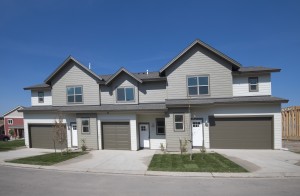The lack of affordable housing in Colorado for middle and lower-income households is a lesson in economics. Unlike the healthcare market, which is muddled with third-party payors, the housing market is straightforward supply and demand analysis. Demand has been far outpacing the supply of housing for the last decade in both the ownership and rental markets, driving up housing inflation across Colorado.
READ: Evergreen Real Estate Group Leads Affordable Housing Development in Globeville
Housing costs have been rising dramatically throughout the state and nation. Since the pandemic, housing has been the greatest driver to our high inflation rates. Even slow- and no-growth areas like the Lower Arkansas River Valley east of Pueblo have experienced dramatic housing inflation even though job growth is minimal in the area. Moderate income Front Range retirees and workers are relocating to the area due to affordability, and investors have followed suit thinking cheap housing assets within a couple of hours of urban areas are a good long-term investment.
Housing is a basic need where demand is driven by household growth, which is influenced by birth and death rates and urban concentration of economic opportunity pushing migration. In recent decades, relative affluence across much of America has also resulted in housing as an investment through second homes and the acquisition of investment properties. Even the tourism market is increasing housing demand through short-term rentals. Global capital markets, perceiving better potential returns from housing investments, are funneling dollars into the U. S. from around the world. This started after the 2001 dot-com bust and has continued except for the years surrounding The Great Recession. The low-interest rate environment since 2009 added massive fuel to the fire until 2022.
For prices to be increasing so dramatically, demand growth must be far exceeding supply growth – at least supply that meets societal expectations of “suitable housing.” As a result, market adaptation is occurring. More rental households are paying at least 50% of their income in rent. Households are doubling up. Multi-generational households are increasing. Average new unit sizes are decreasing. There is some localized pushback on short-term rentals. RV and van alternative lifestyles are becoming much more prevalent. Innovators are manufacturing tiny homes, pre-fab factories, and even 3-D printed homes. These substitutes for traditional housing attempt to remain a step ahead of homelessness.
Our governments, at every level, effectively limit housing supply that could be suitable alternatives to the above market adaptations. They constrain the housing supply growth through adoption of more stringent building codes, planning and zoning limitations, and cumbersome land entitlement processes. A study we did for the Colorado Springs Home Builders Association a few years back found local government requirements equate to 26% of the total price of new housing. Even when local land use policies support new and more affordable housing types being developed, democratic processes are heavily influenced by people who advocate for greater housing opportunity as long as it’s “not in my back yard.” The result is discrimination based on income at the very least.
READ: New Approaches to Affordable Housing in Resort Communities
It is not just governments and NIMBYs that greatly constrain the housing supply. Great hindrances to the supply side come from insurance companies, fire professionals and environmental groups interested in protecting property, public safety and long-term sustainability, respectively.
Culturally and politically constraining our ability to increase the supply of traditional housing results in housing-costs indices rising much more rapidly than incomes over the last half-century. No wonder the corporate and investment sectors see nothing but long-term opportunity in housing and are funneling money into the market.
The federal government’s effort to counter the supply constraints through low-income tax credits or direct investment through local housing authorities is absurd. Building enough housing to standard housing codes and socially acceptable sizes probably cannot be done without dramatic cutbacks to Medicare and Medicaid – assuming neighborhoods did not organize to oppose workforce or affordable housing.
We need to re-engineer our societal constraints on the housing supply. Re-engineering requires radical redesign with targeted cost savings of at least 30%. Throw out the legacy models that hinder us and start over, using new technologies and emerging realities like climate change. Re-engineer building codes, public inspection processes, and land entitlement rules and regulations. There should be six objectives:
- Mitigate fire risks where fires are most likely to erupt.
- Pursue density.
- Allow development generally consistent with current zoning, and reallocate planned land uses to minimize NIMBYism
- Encourage existing small property owners to participate through the addition of mother-in-law apartments and accessory dwelling units.
- Keep residential areas residential as opposed to commercial tourist zones; 6) embrace new housing designs, materials and production approaches.
Unfortunately, re-engineering requires we quit being our own worst enemy – something much easier said than done. It’s time to fight housing inflation in Colorado, once and for all.
 Tom Binnings is a senior partner at Summit Economics in Colorado Springs. He has more than 30 years of experience in project management, economic and market research, real estate development, business analytics and strategic planning. He can be reached at (719) 471-0000 or [email protected].
Tom Binnings is a senior partner at Summit Economics in Colorado Springs. He has more than 30 years of experience in project management, economic and market research, real estate development, business analytics and strategic planning. He can be reached at (719) 471-0000 or [email protected].







